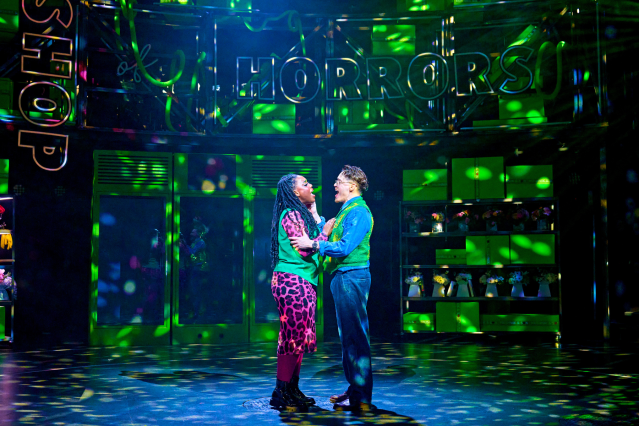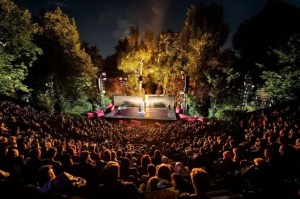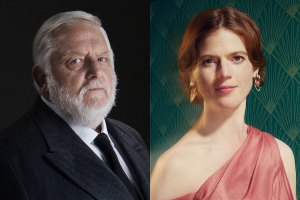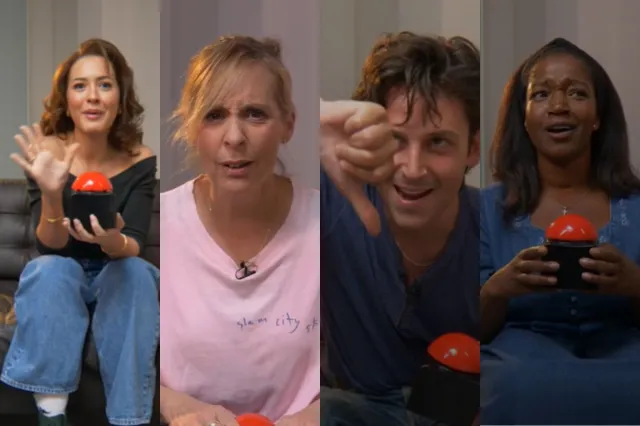Somewhere that’s British – inside Sheffield’s Little Shop of Horrors revival
The creative team and stars discuss today’s Skid Row!

Choosing Little Shop of Horrors as a Christmas offering might seem a little unconventional. But the team at Sheffield Theatres are convincing in their choice.
The madcap musical is obviously very green, being set in a flower shop. It’s a comedy, with a few scares thrown in, because who doesn’t enjoy a festive spook? And, it’s a love story between two underdogs, Seymour and Audrey, who get pulled into the lull of capitalism. We’re all guilty.
“They want a better life, and how do most of us get that?” Director Amy Hodge asks. “It’s from access to the plant and that plant represents money, greed, capitalism. It’s the only way they can see to improve.”
For those yet to be acquainted with the Alan Menken-Howard Ashman musical; it follows a down-on-his-luck flower shop worker who raises a flesh-eating plant, lovingly named after his co-worker crush, Audrey. As Audrey II becomes an attraction, Seymour sees fame, riches, and love, but at what expense?
The action plays out on Skid Row – a poverty-stricken urban neighbourhood. In this Little Shop the creative team has incorporated faces many of us see every day, from nail shop ladies to shop owners and healthcare workers.
“When you put those real-life characters that we know and love and are part of our communities, and you partner that up with a plant, which I think we’re representing as a much bigger, idealistic view of capitalism and the system that keeps people down,” choreographer Jade Hackett starts, “That’s where we’re trying to change what some of the show means and how that matters to the terrain of what we’re seeing in politics, in marching and voting, all the things that have bought people together in previous years.”
Part of that includes using British accents and sounds throughout the show. “It’s been a really good tool that has shifted and changed the tone of the show… it brings it home and feels a bit more of an inclusive, relatable show,” Hackett says.
“It feels like now,” Hodge adds, “We’ve spent a lot of time talking about what is Skid Row today. What’s Skid Row in Sheffield, London, Leicester? Wherever you live.”
The musical had its premiere in the early 1980s and has been delighting audiences around the world since. “It’s funny and it’s silly… It has horror, amazing gags, and amazing music,” Hodge says.
Its songs are among those most recognisable; the hummable title song, the yearning “Somewhere That’s Green,” and the love ballad, “Suddenly, Seymour”. You can hear the cast perform “Skid Row” below:
In a show that has previously been “predominantly driven by male energy,” Hackett and Hodge are proud to be part of the female-led team staging this reimagining. They say “it has affected the storytelling,” and that there’s “an inherently female energy” particularly in Audrey’s relationships.
“Ellen Greene is the most iconic woman ever,” Georgina Onuorah says of the actress who originated Audrey both on stage and screen, “nobody could ever fill her shoes.”
With Greene as the blueprint, Onuorah is putting a more “grounded” spin on the character – a contrast to her co-star Colin Ryan’s take on Seymour. He says: “You get to go on so many twists and turns, and his morals and ethics get pulled in so many different directions… That’s the thing about amazing material, there’s so many ways it could be done.”
Ryan grew up watching shows like French and Saunders and Fawlty Towers. He says Julie Walters is his hero: “She is absolutely hilarious, but she can break your heart as well.”
And the duo hope to do the same in Little Shop of Horrors. “The comedy of the show is in how much heart there is,” Onuorah adds, “it’s so genuine and based on real emotions.”
Ryan adds previous iterations have been played for laughs and become slapstick, but he plans to “play it straight”, adding, “Good comedies can make you laugh and cry, almost at the same time.”

It was important to cast these twisted characters: Mr Mushnik’s rags to riches ego (Michael Matus), the “man child” sadistic dentist Orin (Wilf Scolding), and of course our antagonist plant (Sam Buttery), in a way that fits the new modern approach.
They looked at the appreciation of class in America and how it’s different here in the UK, asking with Orin for example: “Who is this entitled, moneyed, Harley Street dentist and what does he look like in this moment?”
The first thing anybody asks in a production of Little Shop of Horrors is: how are they going to do the plant? and we did, too.
“The way we’re interpreting the plant is that as she grows in size, she grows in people and it’s beautifully choreographically driven in that the ensemble embodies her growth as she gets greedier,” explains Hodge.

Sam Buttery says: “I get to be the most childlike, petulant version of myself because all of that is there in Audrey II,” The plant takes over the Crucible’s thrust stage in a semi-immersive staging. “There’s a real language of movement… and there’s some action movie-like scenes that feel really cool.”
While there’s death and destruction, and even some political commentary, ultimately, Little Shop of Horrors is about an evil alien plant, and as Onuorah says: “You can only take it so seriously.” Which makes it a fun festive title to really sink your teeth into.















